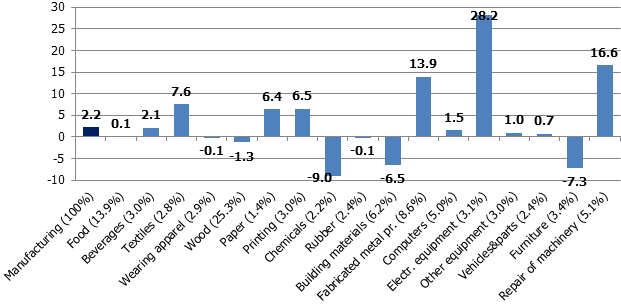AGNESE RUTKOVSKA – Economist, Latvijas Banka –
Growth in the manufacturing subsectors remains heterogeneous: in some subsectors, growth is hampered by weakening external demand, while others are still facing capacity-related issues on the supply side, i.e. the shortage of equipment and staff. Overall, however, the influence of external factors is becoming more pronounced.
As expected, the wood industry, the largest manufacturing subsector which still recorded a strong year-on-year increase in the first quarter, and the manufacture of building materials saw significant changes in comparison with the beginning of the year due to a decreasing demand leading to output declines. The weak performance recorded for the manufacture of building materials is associated with the weakening of the external demand, notably that of Sweden (an important market for the subsector). This trend will most likely continue. The number of building permits granted in Sweden has decreased since the beginning of the year. Moreover, the construction output has also slightly declined over the last months. Meanwhile, the capacity utilisation in the wood industry and the manufacture of building materials in Latvia has declined somewhat over the last year.
At the moment, the high technology sectors, the manufacturing of electrical appliances in particular, still demonstrate dynamic growth and remain the most important contributors to the manufacturing sector. Meanwhile, the manufacture of fabricated metal products has also recorded strong output growth rates. However, the performance of these subsectors is also likely to be affected by the weakening external demand.
According to the European Commission data, the industrial confidence indicators are also less optimistic with respect to export orders, output volumes and selling prices. Thus, manufacturers feel increasingly more affected by external demand. It should be noted, however, that the slowdown in the economic growth, inter alia, the moderation in the manufacturing output growth, was already expected and has been taken into account in Latvijas Banka’s forecasts of macroeconomic indicators.
Volume indices of manufacturing subsectors in the second quarter of 2019 (%; year-on-year; output weights in %)




